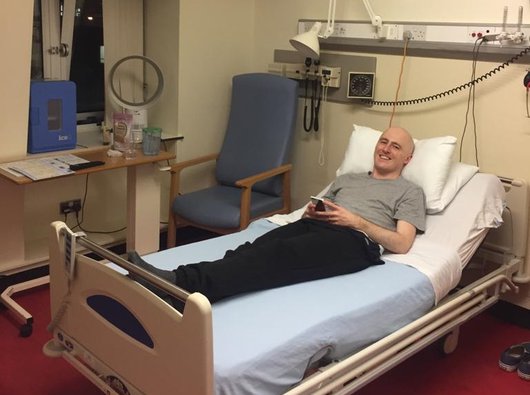Acute myeloid leukaemia (AML) treatment
Measuring your response to treatment and remission
During treatment, you'll have tests to monitor your AML and how you are responding to treatment.
Here we explain the different types of tests and what the results mean.
On this page:
"My top piece of advice is: if you don’t understand something, ask and ask again. You’re not expected to understand everything, and no question is too silly!"
Anna, diagnosed with AML in 2015.

Blood tests
You'll have regular blood tests to check if the leukaemia, or the treatment, is affecting your healthy blood cells. If this happens, you might need a red blood cell or platelet transfusion.
We explain further down the average ranges for different blood counts.
You’ll also have regular blood tests to check that your liver and kidneys are working well, as these are often affected by leukaemia treatment.
Bone marrow biopsy
AML starts in the bone marrow, so checking the bone marrow for leukaemia cells (blasts) is an important test. A bone marrow test will almost always be done as part of the initial process of diagnosing AML. You are also likely to have further bone marrow tests during and after treatment. Comparing the results at different times will show how well the treatment is working.
A bone marrow biopsy involves removing a sample of bone marrow from your hip bone. When looked at under a microscope, this can show how many leukaemia cells (blasts) are in your bone marrow, and whether you are in remission.
What do the results mean?
Tests that monitor how well your treatment is working will look at how many blasts (leukaemia cells) are in your bone marrow, and whether you have enough healthy blood cells of all types.
You might find it helpful to use a health information folder to keep everything in one place, like hospital letters or blood results.
What are blasts?
Blasts are very young blood cells. They are normally found in the bone marrow, where they grow into fully functioning blood cells, before moving into the bloodstream to do their jobs in the body.
If you have AML, your body makes too many blasts (also called myeloblasts), and they don’t develop fully. This means there are lots of immature blasts in your bone marrow and blood. These are leukaemia cells.
In someone healthy, the bone marrow contains less than 5% blasts and there wouldn’t be any in the blood. In AML, there can be high numbers of blasts in the bone marrow and the blood.
Your doctors will use blood tests and bone marrow biopsies to measure how many blasts you have. AML is usually diagnosed if the number of blasts is 20% or more. When treatment is working, this number will go back down.
Complete remission (CR)
Complete remission means you have less than 5% blasts in your bone marrow, and all your other blood cell counts have recovered to normal levels. This indicates that the bone marrow is working normally again.
Complete remission with incomplete recovery (CRi)
Complete remission with incomplete recovery (CRi) means you have less than 5% blasts in your bone marrow, but your healthy blood cell counts like neutrophils (white blood cells) and platelets haven’t all fully recovered.
If you have complete remission with incomplete recovery, you are still in remission.
Measurable/minimal residual disease (MRD)
Measurable residual disease (previously called minimal residual disease), or MRD, means there is still a small number of leukaemia cells left in the body after treatment. You can have MRD even when you are in remission.
Because of the very small number of cells, these aren’t picked up when looking at samples down the microscope. So, you might be in remission, and an MRD test might come up positive, showing that you still have a very small number of leukaemia cells.
MRD tests are much more sensitive than conventional bone marrow biopsies and blood tests, and have hugely improved our ability to spot when AML might relapse.
Complete molecular remission, MRD negative
Complete molecular remission means you are in complete remission and there is no sign of leukaemia in your blood or bone marrow, even after using the very sensitive MRD tests explained above.
"Once I was facing the treatment plan, I was full of fear. I was scared of the chemotherapy, but also scared it wouldn't work."
Yvonne, diagnosed with AML in 2018.
Read Yvonne's story about the Emotional impact of treatment.

Blood counts
AML and its treatment can reduce the number of healthy blood cells you have.
There are three main types of blood cell – red blood cells, white blood cells and platelets. They all do different important jobs in the body. There are several different types of white blood cells, including neutrophils, lymphocytes and monocytes.
Your doctors will measure the levels of key blood cells. If your counts are too low for one or more types of blood cell, your doctor may adjust your treatment or give you a red blood cell or platelet transfusion, to keep your blood counts within safe limits.
Everyone has slightly different numbers of each type of blood cell. If you’re healthy, your blood counts will normally fall within the ranges we mention below. But blood counts can vary depending on your sex, age and ethnicity. For example, people from African Caribbean heritage have slightly lower blood counts than those who are white.
Ask your medical team what your blood test results and numbers mean, because they know what’s normal for you.
- Red blood cells – Your doctors will look at your levels of haemoglobin (a substance found in red blood cells that carries oxygen). In someone healthy, this level can range from 115 to 180 (measured in grams per litre). You will usually need a blood transfusion if this level goes below 80.
- Platelets - In someone healthy, the level of platelets can range from 150 to 400 (measured in billion cells per litre). If this level goes below 10, you might need a platelet transfusion.
- White blood cells - In someone healthy, this level can range from 4 to 11 (measured in billion cells per litre). Leukaemia cells are a type of white blood cell, so when somebody is first diagnosed with AML the levels can be very abnormal.
- Neutrophils – Neutrophils are healthy white blood cells that protect you against infection. For a healthy person, the level can range from 2 to 7.5 (measured in billion cells per litre). Most leukaemia treatments make the number of neutrophils go down, and intensive treatments can make it go down to zero for several weeks. During this time you are at high risk from infections (neutropenia) and need strong antibiotics if this happens. When the neutrophil count goes back up, your body is better able to fight infections by itself.
- Lymphocytes – For this other type of white blood cell, the level can range from 1.5 to 4.5 (measured in billion cells per litre). Lymphocyte levels are usually less affected by AML treatment than other blood cell types.
"When I was first diagnosed with AML, I wanted to know every single detail.
What the blood counts meant, the names of the drugs, how treatment was affecting my blood counts. I was very analytical, and I became quite fascinated with my body and the science/biology of it all." Graeme, diagnosed with AML in 2017.
Talk to other people with AML in our online forum.

